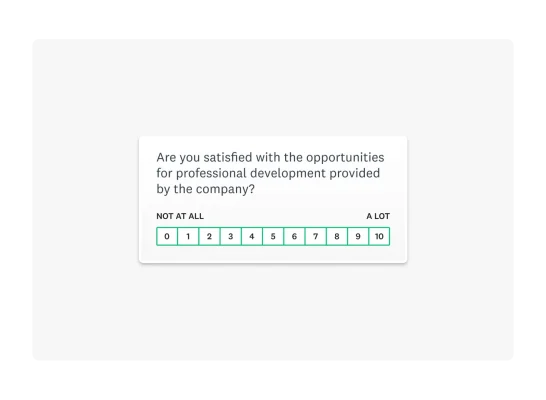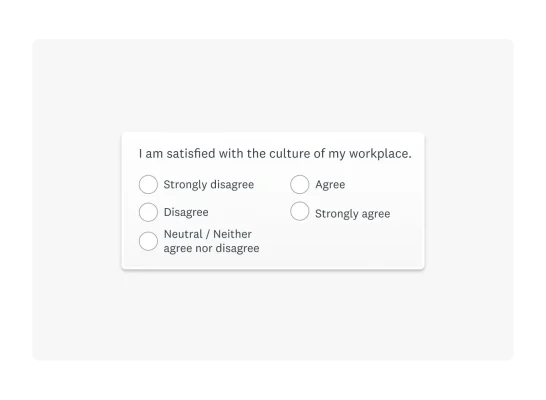20 proven employee retention strategies to reduce turnover
Boost employee engagement and retention with these tips and strategies for HR professionals.

Employee stress levels are at a record high, and the impact reflects employee retention rates. According to a Gallup study, 51% of employees are open to leaving their current company, indicating a need for many organizations to bolster their employee retention efforts.
Keep reading to learn why employee retention matters and 20 strategies to keep talent around long term.
Employee retention overview
What is employee retention?
Employee retention refers to an organization's ability to retain high-performing employees and minimize turnover.
You can increase employee retention by creating a healthy work environment and prioritizing company culture, growth opportunities, and employee engagement. Employee retention is connected to employee satisfaction and loyalty.
How to measure employee retention
Employee retention rate is the inverse of employee turnover, measuring the percentage of employees who remain with the organization over a given period. While the turnover rate reflects those who leave, the retention rate indicates who stays.
To calculate employee retention, you’ll need to know:
- Specific timeframe: The time frame you choose will depend on your organization’s needs, but calculating employee retention monthly or quarterly is recommended.
- Number of employees on the first day of the timeframe: Only count the employees who were working for your organization on the first date of the period. Do not include new hires who started after the first day of your timeframe.
- Number of those employees who worked at your organization at the end of the timeframe.
The formula you will use to calculate employee retention is:
Retention rate = (Remaining headcount/Beginning headcount) x 100
For example, to calculate your company’s retention rate for the past quarter, you would note that you had 50 employees on the first day of the quarter. At the end of the quarter, 47 of the 50 original employees remained.
(47/50) x 100 = 94% employee retention rate
Employee retention statistics
What is a good employee retention rate? In general, 90% or higher is considered a good employee retention rate.
However, average retention rates differ among industries. This is due to several factors, including layoffs, intense workloads, and lack of career growth opportunities.
For example, the average retention rates for a few popular industries are as follows:
- Technology: 40%
- Manufacturing: 71.4%
- Retail: 67.1%
- Finance: 80.2%
- Healthcare: 64.3%
20 strategies to improve employee retention
Improving employee retention reduces turnover costs, boosts productivity, and helps develop an experienced workforce. Luckily, there are steps you can take to improve employee retention.
Read on for 20 methods to ensure your talented employees stick around.
1. Celebrate milestones
Celebrate employee milestones like work anniversaries with meaningful acts of appreciation to increase employee retention. Acknowledging employees' contributions shows that they are seen and valued. Acts of appreciation can look like distributing gift cards, an extra day of PTO, or a dessert to enjoy with coworkers.
2. Offer competitive compensation
According to a Lattice study, 55% of employees left their jobs for a higher compensating opportunity, showing the importance of fair and competitive compensation.
Compare your compensation package to industry benchmarks to understand where your company stands. If competitors pay employees significantly more than what you offer, you may have a retention issue.
3. Build a strong employee benefits program
An employee benefits program is integral, as compensation including nonmonetary benefits impacts employee morale and satisfaction.
According to SHRM, some highly sought-after benefits include flexible schedules, more paid leave, career development opportunities, and tuition assistance. But it’s also best to ask for specific feedback. Gathering feedback with an employee benefits survey enables HR teams to understand what benefits employees value most and need.
4. Conduct stay interviews
Managers use stay interviews to identify what fuels company loyalty and persuades employees to stay. These interviews should be conducted two to three times annually for the best results.
This strategy effectively enhances retention by enabling managers to address potential risks before they lead to employee turnover. Additionally, stay interviews show that leadership cares about employee experience and making continuous improvements.
5. Invest in learning & development
According to Gallup, 59% of millennial respondents said learning opportunities were extremely important when applying for jobs. These opportunities enable employees to upskill and reskill.
Investing in learning and development opportunities shows employees that you value their personal and career growth. Some popular learning and development options include Lunch n’ Learns, online courses, and AI training.

6. Start an employee recognition program
According to our research, 82% of employees consider recognition a key part of their happiness at work. Starting or improving your organization’s employee recognition program can help boost morale and prevent turnover.
You can do this by establishing specific measures to recognize employees for excellent performance. For example, conduct a weekly employee spotlight or use employee recognition software to automate your efforts.
7. Offer regular performance feedback
Employee evaluations support career development and advancement and promote job satisfaction. By providing frequent feedback, managers can support employee growth and skill development. This can also increase productivity levels and employee engagement.
To conduct performance reviews, use performance review surveys such as self-assessments and manager evaluations to identify skills gaps. Performance reviews should be conducted at least on a quarterly or bi-annual cadence.
8. Prioritize mental health
In our study, 45% of employees responded that anxiety or depression negatively impacts their productivity at work. Employees who feel supported at work and receive mental health benefits or resources are more likely to feel satisfied.
Organizations can prioritize workplace mental health by implementing an Employee Assistance Program (EAP) that offers confidential mental health support services.
9. Proactively address burnout
Our survey found that 47% of respondents reported feeling burnt out within the previous six months. Proactively addressing burnout plays an important role in employee retention.
To mitigate and prevent employee burnout, promote interpersonal connections, establish clear career advancement pathways, and cultivate a sense of organizational pride. Pulse surveys are a great way to gather real-time insights from employees to aid in your efforts.
10. Encourage employee feedback
Employee feedback is invaluable for organizations, especially when it comes to retention efforts. Creating a culture of employee feedback comes down to building a safe and transparent environment in which employees feel comfortable sharing their thoughts and opinions.
Employee feedback is important because it allows leaders to fully understand what areas of an organization need improvement.
11. Foster a positive company culture
Employees who feel supported, valued, and comfortable in their work environment are less likely to seek opportunities elsewhere. A positive work culture should be based on shared values and inclusion. By strengthening your internal brand and integrating employee feedback, you can cultivate a workplace culture that employees value and appreciate.

12. Provide advancement opportunities
In a Harvard Business Review study, 86% of employees stated they would leave their current job for another offering more advancement opportunities. Companies can encourage employee retention by promoting from within and creating employee growth plans. A roadmap with career advancement milestones and performance reviews can help employees understand opportunities for upward mobility.
13. Create an effective onboarding program
Effective onboarding has been shown to boost retention by 82%. An effective onboarding program prepares new employees for success by integrating them into the company culture and providing comprehensive job training.
HR teams should preboard and engage employees to set expectations and stir excitement. The employee onboarding program should extend to 90 days and beyond to ensure new hires have the tools and knowledge for success.
14. Provide transparent organization updates
Employees want transparent updates on progress toward company goals, upcoming changes, and the direction of the business. This transparency helps employees understand how their efforts contribute to the organization’s success, which can improve engagement and morale.
One method of providing organizational updates is hosting monthly or quarterly town hall sessions or all-hands meetings. Use this opportunity to present relevant updates and allow time for an open forum to address employee questions.
15. Focus on work-life balance
With the advancement in technology and increased remote or hybrid setups, work and personal life are more intertwined. This means that employees must be strategic in creating a balance between their professional and personal lives.
Employers should support employees in their quest for work-life balance by offering flexible schedules, paid vacation time, company holidays, and mental health resources. Check in with employees regularly to ensure their workload is manageable and that they feel supported at work.
16. Use employee retention solutions
Employee retention tools such as recognition platforms, feedback systems, and onboarding software can effectively reduce turnover and foster positive organizational change.
For instance, investing in an employee feedback platform like SurveyMonkey helps organizations gauge employee engagement and job satisfaction and gather opinions on how to improve company culture. Collecting regular feedback from employees enables organizations to take action from the valuable insights gleaned.
17. Invest in quality leadership
Company leaders are responsible for creating a healthy environment for employees to succeed. Effective leaders are transparent, empathetic, and approachable. These qualities ensure employees feel comfortable voicing their thoughts and opinions to leadership.
One way to invest in your leadership team is to prioritize leadership development programs. These programs help leaders strengthen communication and conflict resolution skills, and learn to inspire their teams. Employees with supportive leaders are more likely to stay engaged and productive in their roles.
18. Hire smart
Employee retention starts with hiring the right people. Do your due diligence when recruiting and hiring new employees. For the best results, ensure the candidates you hire align with your organization’s values and fit well with your workplace culture.
Hiring for potential versus experience is a great place to start. When you hire someone for their potential and provide the resources or training they need, you can develop their skills. Also, hire using your company values as guiding lights to help find the best-fit talent for your organization.
19. Start a mentorship program
Mentorship programs are powerful drivers of employee development and aid in retention efforts. Pairing experienced employees with newcomers provides opportunities for knowledge-sharing, skill development, and personal growth. These types of programs also create a culture of collaboration which boosts job satisfaction and loyalty.
Starting a mentorship program shows employees investment in their success. The support newer employees receive from their mentors is invaluable to retention. Mentorship programs encourage employees to build strong connections with one another which contributes to the
20. Create a clear vision
Employees want to feel connected to the purpose of their organization. Employers should communicate a clear vision for the company. Evaluate your values and mission statement to ensure they align with your current company’s vision. Additionally, you should share this vision through your communications, such as employee newsletters, meetings, and one-on-ones.
Creating and communicating a clear vision to employees is vital to employee retention efforts. By ensuring a crystal clear vision, you provide employees with a sense of purpose and increased motivation. A well-defined vision inspires employees to work harder and stay with an organization for longer.
All of these strategies are effective methods for improving employee retention rates. Reducing employee turnover will significantly impact your company’s bottom line and help attract talented individuals.
Employee retention FAQs
- Why is employee retention important?
- What are the 3 R’s of employee retention?
- What improves employee retention?
Improve employee retention with feedback
Employee retention is an essential part of protecting a company’s bottom line. Regularly measure your employee retention rate to ensure you aren’t falling below industry standards. By implementing the strategies outlined in the article, HR teams can improve productivity and job satisfaction while positively impacting retention.
SurveyMonkey HR solutions help teams recruit top talent, hire faster, streamline onboarding, build high-performing teams, and maximize engagement to promote employee retention. With SurveyMonkey, you can quickly measure employee satisfaction and address areas for improvement, support growth and development with evaluation surveys, and collect feedback on employee benefits.
Get started today.
Discover more resources

HR toolkit: Make employee experience your competitive advantage
HR leaders can use this toolkit to help drive exceptional employee experiences.

eNPS Benchmarks: Measure and Improve Employee Engagement
Understand what makes a good eNPS, how to measure it, and discover effective strategies to increase employee engagement and retention.

Employee satisfaction: Why it matters and how to improve
Satisfied employees are happier and more productive. Learn how to measure and boost employee satisfaction to create a workplace people love.

Employee engagement strategy: How-to and best practices
Discover strategies to engage your workforce and improve retention. Learn how employee engagement can lead to better performance and profits.